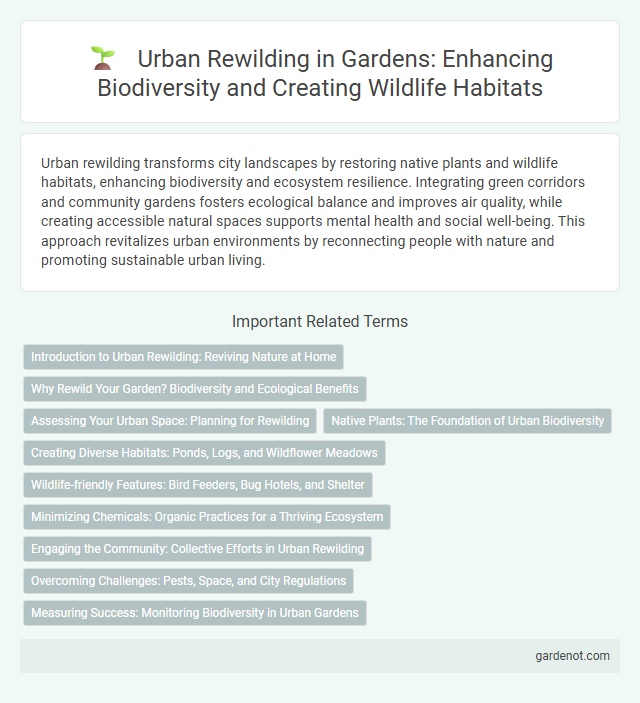Urban rewilding transforms city landscapes by restoring native plants and wildlife habitats, enhancing biodiversity and ecosystem resilience. Integrating green corridors and community gardens fosters ecological balance and improves air quality, while creating accessible natural spaces supports mental health and social well-being. This approach revitalizes urban environments by reconnecting people with nature and promoting sustainable urban living.
Introduction to Urban Rewilding: Reviving Nature at Home
Urban rewilding transforms city landscapes by reintroducing native plants and wildlife to create self-sustaining ecosystems within urban environments. Integrating green corridors, community gardens, and natural habitats enhances biodiversity, improves air quality, and supports mental well-being for residents. This approach promotes sustainable urban living by restoring natural processes and reconnecting communities with their local environment.
Why Rewild Your Garden? Biodiversity and Ecological Benefits
Rewilding your garden enhances local biodiversity by creating habitats for native plants, insects, birds, and pollinators, which supports ecosystem resilience. Native vegetation promotes soil health, improves air quality, and helps regulate local climate through natural cooling and water management. Restoring natural ecological processes in urban spaces contributes to greater environmental balance and sustainable urban living.
Assessing Your Urban Space: Planning for Rewilding
Assessing your urban space for rewilding involves evaluating soil quality, sunlight availability, and existing vegetation to determine suitable native plant species. Mapping out potential areas for wildlife corridors and green patches helps create biodiverse habitats that support pollinators, birds, and small mammals. Incorporating local ecological data ensures the rewilding plan enhances urban biodiversity while promoting sustainable ecosystem services.
Native Plants: The Foundation of Urban Biodiversity
Urban rewilding relies on native plants as the cornerstone for restoring biodiversity within city landscapes, providing essential habitats and food sources for local wildlife. These indigenous species support pollinators, birds, and insects, creating resilient ecosystems that adapt to urban environmental stresses. Incorporating native flora enhances ecological connectivity and promotes natural processes, fostering healthier and more vibrant urban environments.
Creating Diverse Habitats: Ponds, Logs, and Wildflower Meadows
Urban rewilding enhances biodiversity by integrating diverse habitats such as ponds, logs, and wildflower meadows within city landscapes. Ponds support aquatic species and provide breeding grounds for amphibians, while logs create microhabitats for insects, fungi, and small mammals. Wildflower meadows attract pollinators like bees and butterflies, promoting ecological balance and enriching urban ecosystems.
Wildlife-friendly Features: Bird Feeders, Bug Hotels, and Shelter
Urban rewilding enhances biodiversity by integrating wildlife-friendly features such as bird feeders, bug hotels, and natural shelters into city landscapes. Bird feeders attract native and migratory species, supporting avian populations, while bug hotels provide essential habitats for pollinators and beneficial insects, promoting ecological balance. Natural shelters like log piles and dense shrubbery offer protection and breeding sites, encouraging diverse wildlife and contributing to urban ecosystem resilience.
Minimizing Chemicals: Organic Practices for a Thriving Ecosystem
Urban rewilding thrives through minimizing chemical use by adopting organic practices such as natural pest control and composting, which support soil health and biodiversity. These methods reduce pollution and promote the proliferation of native flora and fauna, creating resilient ecosystems within city environments. Emphasizing chemical-free management fosters a balanced urban habitat that reconnects residents with nature and enhances ecosystem services.
Engaging the Community: Collective Efforts in Urban Rewilding
Urban rewilding thrives through active community engagement, where collective efforts transform neglected spaces into vibrant ecosystems. Local residents collaborate with environmental organizations to plant native species, create green corridors, and promote biodiversity within city landscapes. These initiatives foster environmental stewardship, enhance urban resilience, and improve overall quality of life by reconnecting people with nature.
Overcoming Challenges: Pests, Space, and City Regulations
Urban rewilding faces significant challenges including pest management, limited green space, and complex city regulations that can hinder habitat restoration. Innovative solutions such as integrated pest control, vertical gardens, and adaptive zoning policies are critical to creating thriving ecosystems within urban environments. Collaboration between ecologists, city planners, and local communities drives the successful implementation of rewilding initiatives despite these obstacles.
Measuring Success: Monitoring Biodiversity in Urban Gardens
Urban rewilding initiatives rely on systematic monitoring of biodiversity in urban gardens to assess ecological recovery and species richness. Employing techniques such as bioacoustic surveys, native species inventory, and soil health analysis provides quantifiable data on habitat quality and ecosystem services. Effective measurement protocols enable adaptive management strategies that boost biodiversity and promote resilient urban ecosystems.
Urban rewilding Infographic

 gardenot.com
gardenot.com